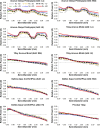Power Profiles of Commercial Multifocal Soft Contact Lenses
- PMID: 27748699
- PMCID: PMC5287430
- DOI: 10.1097/OPX.0000000000000998
Power Profiles of Commercial Multifocal Soft Contact Lenses
Abstract
Purpose: To evaluate the optical power profiles of commercially available soft multifocal contact lenses and compare their optical designs.
Methods: The power profiles of 38 types of multifocal contact lenses-three lenses each-were measured in powers +6D, +3D, +1D, -1D, -3D, and -6D using NIMO TR1504 (Lambda-X, Belgium). All lenses were measured in phosphate buffered saline across 8 mm optic zone diameter. Refractive index of each lens material was measured using CLR 12-70 (Index Instruments, UK), which was used for converting measured power in the medium to in-air radial power profiles.
Results: Three basic types of power profiles were identified: center-near, center-distance, and concentric-zone ring-type designs. For most of the lens types, the relative plus with respect to prescription power was lower than the corresponding spectacle add. For some lens types, the measured power profiles were shifted by up to 1D across the power range relative to their labeled power. Most of the lenses were designed with noticeable amounts of spherical aberration. The sign and magnitude of spherical aberration can either be power dependent or consistent across the power range.
Conclusions: Power profiles can vary widely between the different lens types; however, certain similarities were also observed between some of the center-near designs. For the more recently released lens types, there seems to be a trend emerging to reduce the relative plus with respect to prescription power, include negative spherical aberration, and keep the power profiles consistent across the power range.
Figures











References
-
- Holden BA, Fricke TR, Ho SM, et al. Global vision impairment due to uncorrected presbyopia. Arch Ophthalmol 2008;126:1731–9. - PubMed
-
- Morgan PB, Efron N, Helland M, et al. Demographics of international contact lens prescribing. Cont Lens Anterior Eye 2010;33:27–9. - PubMed
-
- Efron N, Morgan PB, Woods CA; International Contact Lens Prescribing Survey Consortium An international survey of daily disposable contact lens prescribing. Clin Exp Optom 2013;96:58–64. - PubMed
-
- Efron N, Nichols JJ, Woods CA, et al. Trends in US Contact Lens Prescribing 2002 to 2014. Optom Vis Sci 2015;92:758–67. - PubMed
-
- Akerman DH. 40 is the New 20/20—presbyopia equals opportunity. Contact Lens Spectrum 2010;25:3 Available at: http://www.clspectrum.com/articleviewer.aspx?articleID=103978. Accessed: July 15, 2016.
MeSH terms
LinkOut - more resources
Full Text Sources
Other Literature Sources
Medical

